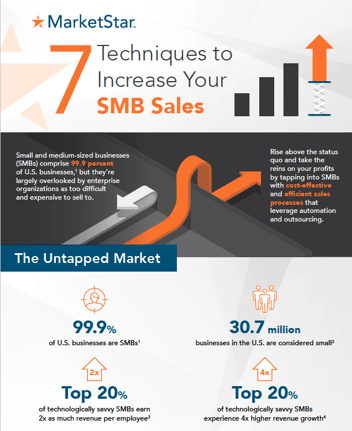For every big customer you land, there are dozens of small and medium-sized businesses (SMBs) out there that are looking for products exactly like yours. However, most enterprise companies ignore SMB sales, assuming that SMBs are too difficult to sell to and too expensive given the size of their typical contract.
If you are among those who are overlooking SMB sales, then you are ignoring an untapped market that is hungry for technology.
There are 30.7 million SMBs in the United States and they are each spending between $10,000 and $49,000 per year on technology. As a group, they are spending $1.2 million annually on cloud computing.
However, they don’t buy like enterprise customers. They tend to buy like consumers, researching options and narrowing their search before contacting the vendor.
Part of the reason your in-house sales team isn’t selling to SMB prospects is because SMBs don’t want to be sold to, they want to be helped. SMB decision makers understand what they need for their business, but they want to be educated and guided to find the best solution. They will buy from the company that understands how to help them succeed.
Selling into the SMB Space
SMB sales require a different approach. With enterprise customers, you establish a relationship with decision makers and sell what you are offering. It usually requires multiple meetings with various department heads, product demos, trials, contract negotiations, and other steps to convince the enterprise customer and sign a deal.
With SMB sales, the Buyer’s Journey is 70 percent completed by the time the SMB actually contacts the vendor.
Unlike enterprise customers, buying decisions for SMBs are typically made by one or two people, usually the business owners. Because entrepreneurs are extremely busy, they don’t want to deal with sales calls, and instead research solutions in their free time.
Whereas enterprise customers often have more spending flexibility, SMBs have limited budgets and tend to be risk averse, because making the wrong technology decision could mean a costly mistake.
For SMB sales, you can’t just be a supplier, you need to be a consultant. SMBs are looking for solutions that address their challenges, and the vendor that is more interested in providing support and a strong knowledge base.
Restructuring Your Team for SMB Sales
The goal with SMB sales is to maximize the lifetime value (LTV) of the customer, and that means using the right sales support at each stage of the customer journey including adding a Customer Success solution.
- Awareness: At this stage the SMB prospect is self-selecting and, having identified a business need, is conducting research to find the best solution. When you capture that lead, you continue to educate them until they are ready to buy. At this stage the sales process is primarily automated or managed by a customer development representative (CDR).
- Consideration: This is the investigative stage, wherein the SMB buyer is seeking out differentiators and looking to narrow the field. According to Gartner, only 17 percent of the Buyer’s Journey is spent meeting with vendors. The rest of the time is spent doing research and assessing needs until they are ready to engage with the sales rep to get more detailed information and a demonstration. At this point the prospect comes to the sales rep’s attention.
- Commitment: This is the sale. However, the role of the sales rep is not only to close, but also to ask questions to understand how your solution meets their need to both set expectations and promote ongoing support via Customer Success.
- Retention: At this stage the new SMB customers works with the Customer Success team for onboarding and support, and to uncover new sales opportunities. The goal is to promote happy customers who will buy more. You are 60-70 percent more likely to sell to an existing customer, as opposed to a 5-20 percent chance of selling a new prospect.
- Advocacy: By having sales, marketing, and customer support collaborate to promote success from first contact through to onboarding and beyond you will ultimately have a frame of reference that can help you sell to other SMBs.
Outsourcing SMB Sales
Successful SMB selling requires minimizing the cost of customer acquisition and nurturing the customer to maximize LTV. High-touch sales strategies are too expensive, so to cut overhead you can outsource much of the SMB sales process.
Lead nurturing and qualification can be easily outsourced for less than you would have to pay to support in-house staff. Prospect education and relationship building is time consuming and requires regular contact, so it makes sense to hand it off to an outside sales specialist with the expertise and technology to manage it for you.
This frees your sales team to support existing customers and work with SMB prospects when they are ready to buy.
Your sales team isn’t addressing the SMB market because it is a different sales strategy with a different mindset. However, by restructuring your sales process and outsourcing to specialists who understand SMB sales, your sales reps can find new SMB sales success by focusing on what they do best.








